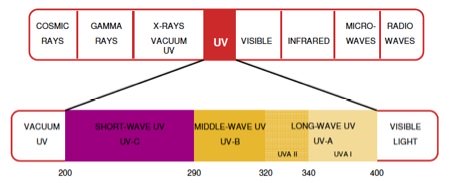Sunscreen Facts
Slip slop slap - it really is not as easy as that!
The more sunscreen facts you know, the better informed you'll be when choosing sun care products for you and your family.
 sunscreen facts help choose your sunscreen
sunscreen facts help choose your sunscreenUsing sunscreen has become one of the easiest forms of sun protection we all rely on today in order to keep our skin safe from sun damage.
There is quite a lot of information about what is good and what isn't but the following aspects will hopefully highlight areas requiring your attention when choosing your sunscreen, as well as how best to use them for ultimate protection.
Sunscreen Facts: how they actually work
Sunscreens absorbs, reflects or scatters UV light rays.
The UV light rays are divided into three wavelength bands - ultraviolet A (UVA), ultraviolet B (UVB) and ultraviolet C (UVC). Only UVA and UVB rays reach the earth.
Sunscreens provide either physical or chemical protection, or a combination of both, from these 2 UV light rays:
- Physical sunscreens:
Form an opaque film on your skin that reflects or scatters UV light before it can penetrate the skin.
They contain ingredients such as zinc oxide and/or titanium dioxide, which protect against both UVA and UVB rays.
Original formulations of physical sunscreens remained white when applied to the skin. Newer formulations have reduced the size of the molecules and enable them to blend more with your skin tone and so are less obvious. - Chemical sunscreens:
Are absorbed into the skin, from where it converts it to a small amount of heat.
There is only one chemical ingredient that absorbs the UVA rays - avobenzone.
Others, such as oxybenzone and octinoxate, absorb the UVB rays only.
For broad UV protection, chemical sunscreens will need to contain more than one ingredient in order to be able to protect against both UVA and UVB rays.
 UV protection ingredients
UV protection ingredientsSunscreen facts: SPF and it's meaning
Easily the one sunscreen fact that most people judge a sunscreen's value by is the SPF, which stands for "sun protection factor".
This appears on all sunscreen packaging as a number, declaring the amount of protection the sunscreen has been tested and certified for. This rating ranges from as little as 4 to as much as 100.
It measures the fraction of sunburn-producing UVB rays that reach the skin. For example, "SPF 15" means that 1⁄15 of the burning radiation reaches the skin through the recommended thickness of sunscreen. It does not indicate the degree of protection from non-burning UVA radiation.
Most common SPF ratings in sunscreens range from SPF 15 to SPF 30. If you don't tend to burn easily when out in the sun, or are already reasonably well tanned, you can choose a sunscreen product with SPF 15. Those with fair skin or who have the tendency to burn easily, should rather opt for a sunscreen with at least an SPF of 30.
From the table below, you can see that the SPF protection curve rises sharply and then trails off.
This is one of the sunscreen facts not commonly known...
- An SPF of 30 will provide 97% protection
- An SPF of 50 only provides for a little more protection, as in 98%
Also:
an SPF of 30 does not double the protection of an SPF15, neither does an SPF 60 double an SPF 30
which are commonly asked questions.
Also:
If you apply SPF 15 over an SPF 30, you will only have a maximum protection of SPF 30.
Not, as some people believe, a combined SPF of 45.
 SPF protection coverage map
SPF protection coverage mapSunscreen facts: Broad Spectrum
What 'broad spectrum' actually means, or implies, varies in many people's minds.
What it actually should mean is that you get protection from all of the long-wave UVA and the medium-wave UVB rays.
Protection from the short-wave UVC rays is not included as they are prevented from reaching the earth's surface by the hemisphere.
Unfortunately, many sunscreens that say that they are broad-spectrum really aren't at all, or don't block the full UVA spectrum. Ie. The full wavelength spectrum from 290 - 400 nm. (see figure below)
To get good protection from UVA rays as well as UVB, look for sunscreens that list titanium dioxide, and/or zinc oxide as one of their ingredients.
 Light ray spectrums
Light ray spectrumsSunscreen facts: expiry dates
Sunscreen details printed on any tube of sunscreen should include the relevant information about when it will expire.
This will relate directly to the ingredients contained within the cream, lotion, gel or spray. Whether a chemical or physical based sunscreen or a combination of both, there will be a limit as to how long they will be effective.
From an expiry point of view, it will be greatly improved the better you look after your sunscreen. Eg. taking it to the beach and leaving it out in the full sun for hours on end will most likely create some sort of impact to the consistency.
Whereas if you make a point of keeping it relatively cool and not exposed, you are likely to retain the quality longer.
Sunscreen facts: Applying sunscreen
 How best to apply sunscreen
How best to apply sunscreenAs a general rule with all sunscreens, apply 20 minutes before going out into the sun and reapply every 2 hours.
But the following sunscreen facts apply:
- A physical sunscreen, upon application, will sit on the skin and create a barrier that reflects the sun's rays, so it is actually able to work almost immediately after application
- Chemical sunscreens are absorbed into the skin and so require a longer time after application to allow them time to work
- Often a sunscreen will contain both chemical and physical, so hence the general rule is to apply 20 minutes before exposure.
Re-application:
- Physical sunscreens only last until you wipe it off or sweat it off.
- Chemical sunscreens in general become less effective once exposed to the sun.
So reapplication often is vital for optimal protection.
If you plan to get wet or sweat excessively, you can choose a sunscreen that is more water resistant than most, but bear in mind the fact they are not likely to be completely waterproof.
Cover all areas exposed:
What many people fail to do is properly is to protect their entire body when applying sunscreen. While you should definitely apply sunscreen to the areas of your body that will be exposed to the sun, it is also important to add a layer of sunscreen to your:
- hands
- fingers
- feet
- toes
- behind the ears
- the back of the neck
These are common areas that are often forgotten and very often the areas that get sun burnt, as well as the common areas for skin cancers.
Sunburns in these areas can also be particularly uncomfortable.




New! Comments
Have your say... please leave me a comment in the box below.